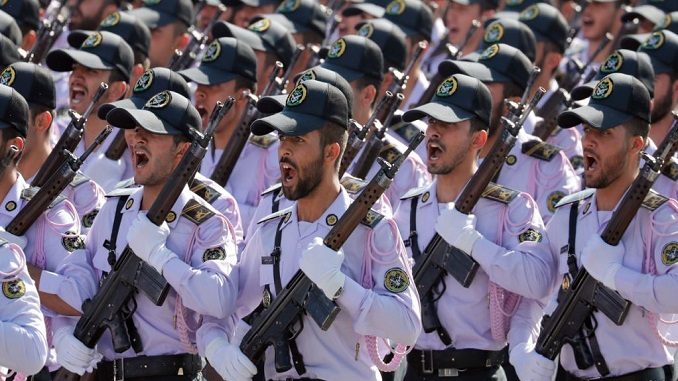
With some Iranians still hopping mad about state spending on religious institutions and foreign military ventures, Supreme Leader Ayatollah Ali Khamenei has green-lighted the siphoning of $2.5 billion from a currency-reserve fund to boost military spending, RFERL reports.
The announcement follows by less than two weeks an official clampdown on street protests over rising prices and other economic grievances that spread to more than 90 cities, according to RFE/RL’s Radio Farda. Public anger had been stoked in December by price hikes but also word of a draft government budget that earmarked major funding for religious institutions and the clerically dominated country’s armed forces.
The December-January protests have heightened scrutiny on state spending, underscored by frustration among Iranians when a gold-plated “Koran ship” was unveiled earlier this month.
On January 24, parliamentary budget-commission member Asghar Yousefnejad said the surprise defense outlay is part of a $4 billion redirection from the Iranian National Development Fund (INDF) ordered by Khamenei, who holds the final say on all political and religious matters in Iran.
Yousefnejad was quoted by domestic media as saying that the rest of the cash will be used to fund projects related to dust pollution, water irrigation and management, and reconstruction of quake-hit and flood-stricken areas. Some $150 million was said to be headed to state TV, which many Iranians criticized for spreading misinformation and offering biased news coverage during the unrest.
President Hassan Rohani was reelected last year in a race dominated by pledges to create jobs in a country where national unemployment was reportedly around 12 percent last year, but more like 30 percent among young people. He and other officials hinted that a 2015 deal with world powers to curb Tehran’s nuclear program in exchange for the lifting of many sanctions might boost Iran’s economic fortunes, but it is not clear that average Iranians have seen any tangible benefits.
The Rohani government’s draft budget that emerged in December outlined cuts in subsidies while it increased funds for the Islamic Revolutionary Guards Corps (IRGC) and religious institutions.
The Financial Times reported earlier this month that since Rohani’s rise to the presidency in 2013, defense spending in the budget has increased by 18 percent and allocations for religious institutions — including Islamic propagation offices and seminaries — have risen by 26 percent.
Iranians recently used the Farsi equivalent of hashtag #Gilded_Koran to question the wisdom of spending state money on a gold-plated replica ship inscribed with the text of the Koran. Some reports later suggested the artist behind that work, which was reported to be donated to a major Shi’ite shrine in neighboring Iraq, had personally covered its cost.
The increase in military expenditure comes on the heels of large-scale protests across major cities in Iran that continued for several weeks. Among other things, protesters criticized the government’s economic policies and its military involvement in regional countries resulting in neglecting the well-being of its citizens. Some analysts believe the regime is spending big chunks of its military budget on foreign military interventions and adding to the military budget means more regime interventions in regional countries.
“Huge amount of this budget will be spent for regional ambitions in Yemen, Syria, Lebanon, and Palestine in support of Iran proxies. Iran extends invaluable support to its allies including Hezbollah, Hamas, Houthis and other Shia militias in the region through various projects,” Babak Taghvaei, a Malta-based Iranian analyst told VOA.
In terms of how much the regime spends to allegedly finance proxy wars in the region, Taghvaei said it is hard to come up with a number because the regime is secretive and denies it finances these regional wars. Alex Vatanka of the Washington-based Middle East Institute thinks the allocation of additional money for defense spending illustrates that the regime is out of touch with ordinary Iranians.
“Earmarking this fund a month after budget planning [for the] defense sector when people are dealing with real vital shortcomings and environmental issues shows how unrealistic and detached decision makers are in Iran,” Vatanka said.
Tehran has reportedly spent billions in propping up its allies in Syria, Lebanon, the Gaza Strip, Yemen, Iraq, Bahrain and Saudi Arabia. Until November 2017 when it was replaced by North Korea, Iran topped the U.S State Department list of state sponsors of terrorism.
“Iran continued its terrorist-related activity in 2016, including support for Hezbollah, Palestinian terrorist groups in Gaza, and various groups in Syria, Iraq, and throughout the Middle East. Iran used the Islamic Revolutionary Guard Corps Qods Force [IRGC-QF] to implement foreign policy goals, provide cover for intelligence operations, and create instability in the Middle East,” U.S. State Department said in its 2016 Country Report on Terrorism.
Tehran denies the charges that it supports terrorism and that it has been engaged in proxy warfare in the region.
